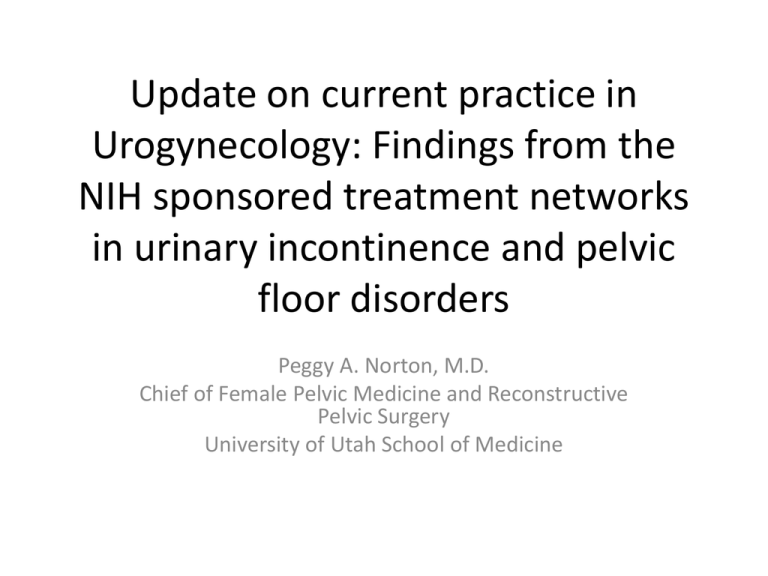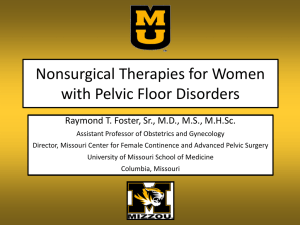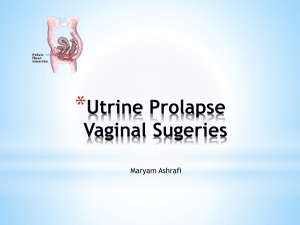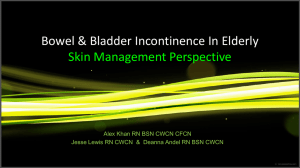
Update on current practice in
Urogynecology: Findings from the
NIH sponsored treatment networks
in urinary incontinence and pelvic
floor disorders
Peggy A. Norton, M.D.
Chief of Female Pelvic Medicine and Reconstructive
Pelvic Surgery
University of Utah School of Medicine
Learning objectives
• Describe main findings from the Urinary
Incontinence Treatment Network (UITN)
• Describe main findings from the Pelvic Floor
Disorders Network (PFDN)
• Be able to identify at least one finding from
the UITN and PFDN that could change practice
in general gynecology in your own community.
98: American
Urogynecologic
Society beg
1998: American
Urogynecologic
lobbying
for NIH
funding
Society Congress
began lobbying
Congress
forin
urogynecology
NIH funding
in urogynecology
Several large clinical treatment networks
emerged and took requests for funding 99-02
• Pelvic pain treatment network (NIDDK)
• Urinary incontinence treatment network (NICHD*)
– Urinary incontinence, both stress and urgency
– Evaluation and treatment
• Pelvic floor disorders network (NICHD**)
– Broader definition included pelvic organ prolapse,
urinary and fecal incontinence.
– Evaluation and treatment
* additional funding by Office of Research in Women’s Health and NIDDK
** additional funding by ORWH and NICHD
Urinary incontinence treatment
network 2001-2014
• What’s the best tx for SUI in women?
– Burch colposuspension versus autologous fascial sling
(SISTEr trial, Stress Incontinence Surgical Efficacy
tRial). RCT, reported 2 and 5 year outcomes, n=655
– Strict composite definitions of success for SUI and for
overall UI (including urgency incontinence)
• Success rate higher with fascial sling, but causes
more problems with voiding, urgency and UTIs.
Success rates decline over 5 years, but sling still
more successful. Women with preoperative
urgency less likely to have successful outcome
Albo et al NEJM 2007 (two year)
Brubaker et al J Urology 2012 (five year)
• Complications of UI surgeries are minimal & transient.
• After effective surgery, women with UI will spend less money on
UI-related expenses.
• The majority of women undergoing surgery for SUI also have
urgency UI, which they expect will get better with the surgery.
• Satisfaction w/ surgery is higher than what is reflected in
composite success rates.
• Despite gradual decline in success of both surgeries over time,
improvements in quality of life continue.
• Counsel that fascial sling has a higher rate of needing takedown,
Burch patients have higher rate of subsequent surgery.
Five year success in SISTER trial
depends on the definition of success
UITN: what’s the best surgical
treatment for SUI in women?
• Mid-urethral mesh slings: RCT retropubic versus
transobturator (TOMUS trial) 2006-2009. One, two
and five year outcomes, n=597
• At 1 year, same objective success, similar
subjective success. At 2 years, similar but not
equivalent. Complications different, but rare.
• By 5 years, objective success 8% higher in
retropubic, subjective success 6% higher in
transobturator, neither difference is significant
• Seven new mesh erosions by year 5-7
Some differences between RetropubicMUS
and TransobturatorMUS
Complication
Intraoperative: rate
perforation of bladder
Immediate postop: rate of
voiding problems
Long term: 2 year rate
exposure of mesh
RMUS
5%
TMUS
0%
3.4%
2%
3%
2%
For midurethral slings overall voiding problems, counsel 6/2 rule:
6 percent of women need a catheter at 2 weeks, and
2 percent need a catheter at 6 weeks
What is the role of urodynamics (UDS) in the
evaluation of women prior to SUI surgery?
• In SISTEr, we were able to standardize
urodynamics and find some important norms,
but we did not see correlation with outcomes.
• In TOMUS, we found that low leakpoint and
low urethral pressures were associated with
surgical failure.
• ValUE: Value of Urodynamic Evaluation was
conceived and eventually went forward
ValUE trial: Nager et al NEJM 2012
• Women undergoing SUI surgery, randomized to
basic office evaluation v. basic eval plus UDS
• UDS did not improve surgical outcomes in women
with uncomplicated SUI: rarely changed the
treatment plan, although this was in a group of
subspecialist surgeons
• Compared to UDS utilization at the beginning of
the trial, calculate saving somewhere between 10
million and 90 million dollars annually in preop
evaluation that doesn’t improve outcome
What about urgency incontinence?
Burgio et al; Ann Intern Med 2008
• Be_DRI (Behavior Enhances Drug Reduction of
Incontinence) 307 women with urgency UI
• Randomized drug v drug + extensive behavioral therapy,
outcome= 70% reduction of incontinent episodes
• Subjects were more satisfied with drug plus behavioral
tx, but getting behavioral treatment did not improve
our ability to discontinue drug treatment
• Measures such as adjusting
fluids improved outcome
How do these studies affect your
practice or patient counseling?
• Patients considering a sling for stress urinary
incontinence can expect improvement in quality
of life that exceeds objective cure
• Urodynamic testing is not necessary prior to
surgery in women with uncomplicated SUI
• Women with urgency incontinence can be
managed successfully with anticholinergic
medications, but adding behavioral management
does not lead to discontinuation of these drugs.
What didn’t the UITN network do?
• No randomized trial between mesh sling and a
fascial sling
• No trial of Botox or neuromodulation (PFDN
did these)
• Could not recruit for trial
of mixed incontinence
• Did not define a “best outcome”
for SUI treatment
Pelvic Floor Disorders Network
• Should we add a continence procedure to major
surgical procedures for pelvic organ prolapse?
• CARE trial 2003-2005 Brubaker et al NEJM 2006
• 322 women undergoing abd sacrocolpopexy
(ASC) for POP without SUI were randomized to
additional continence procedure (Burch) or not
• At three months, 23.8% of those undergoing ASC
plus Burch met criteria for SUI postop, compared
to 44.1% of those who underwent ASC alone.
Similar findings at two years
• No significant increase in adverse events
CARE trial: five year follow-up
(Nygaard et al 2013)
• ASC is not as good as we believed: by five
years, almost a third of subjects met “failure”
criteria, but only 5% underwent repeat
surgery and most reported satisfaction w/ op.
• Prophylactic SUI surgery continued to show
benefit long term, with no adverse
consequences.
• Mesh erosions occur with ASC, too:
approximately 10% by year five
Outcomes following vaginal prolapse repair and
mid urethral sling (OPUS) trial: Wei NEJM 2012
• 337 women undergoing vaginal surgery for
POP who were not incontinent: randomized to
TVT or sham incision.
• At 3 mos, 23.6% of women undergoing TVT
reported bothersome UI compared to 49.4%
of women with sham incisions
• At 12 mos, 27.3% of women undergoing TVT
reported bothersome UI compared to 43% of
women with sham incisions.
Are there good alternatives to anticholinergics
for treating urgency UI?
• ABC Trial: Anticholinergic tx
vs.onabotulinumtoxin A for UUI
Visco et al NEJM 2012
• Women with UUI randomized
to drug/sham bladder injection or
placebo/Botox 200 units bladder injection.
• Cure rates with Botox were twice that seen with
Anticholinergic medications in double blind trial
• Main AEs were UTI and voiding dysfx (10%)
What is the best surgery for vaginal
vault prolapse?
• OPTIMAL trial: Barber et al, JAMA 2013 (Dr.
Scott is reviewing this paper)
• Urogyn perspective: Uterosacral ligament
suspension widely adopted by specialists after
2000 without good evidence. Using
MICHIGAN modification of SSLF, we saw
similar outcomes for both procedures in the
OPTIMAL
What else have we found?
• Colpocleisis study n=152: there is high
satisfaction (95%) after obliterative surgery for
POP in selected women (Fitzgerald
• ATLAS study: Ambulatory Treatments for Leakage
Associated with Stress. Women with SUI
randomized to vaginal pessary versus pelvic floor
muscle therapy versus combined pessary and
muscle therapy. Combination treatment did not
offer improvement over single therapy
How likely is a woman to develop SUI
after surgery for POP? Jelovsek 2013
• Urinary reduction stress test is only 17-34% accurate
• Factors that were found to affect SUI after POP surgery:
–
–
–
–
–
–
–
–
–
–
–
–
Increased age at surgery
White race
Higher vaginal parity
Higher body mass index
Current smoker
Current diagnosis of diabetes
Higher preoperative POP quantification stage
Higher POP quantification point Aa measure
Positive preoperative prolapse reduction stress test
Performance of a concomitant retropubic midurethral sling
Participation in strenuous exercise
Presence of baseline urgency urinary incontinence symptoms
• Calculate risk from 15% to 70%, helps give numbers to discussion between
surgeon and patient
www.r-calc.com
Click on , agree, and then open female pelvic
medicine….
http://www.rcalc.com/administrator/calculatorGridPreview.aspx?isG
rid=1&mobile=0&isTemp=0&calculator_grid_id=b8aa31
f8-6023-493f-87bd-7d5c6553af91
Weighted prevalence rates of pelvic floor
disorders (PFDs) in nonpregnant US women
from the NHANES study (Nygaard et al 2008)
variable
N=1961
UI n=331
FI n= 176
POP n=58 >1 pfd
overall
1961
15.7%
9%
2.9%
23.7%
Age 20-39 641
6.9%
2.9%
1.6%
9.7%
Age 40-59 668
17.2%
9.9%
3.8%
26.5%
Age 60-79 488
23.3%
14.4%
3.0%
36.8%
> 80
31.7%
21.6%
4.1%
49.7%
<.001
<.001
.14
<.001
p
150
How has the PFDN changed the way
we counsel or treat our patients?
• Pelvic floor exercise and vaginal pessaries are
options in the treatment of SUI, but success
rates are lower than surgical options (ATLAS)
• A quarter of women has at least one pelvic
floor defect (NHANES)
• Colpocleisis is an effective surgery with a high
satisfaction rate for selected patients
How has the PFDN changed the way
we counsel or treat our patients?
• Consider adding continence procedure in
women undergoing POP procedures (CARE
and OPUS), possibly using on line calculator
• Sacrospinous ligament suspension and
uterosacral suspensions are good option for
vaginal vault prolapse (OPTIMAL)
• Botox should be considered in the treatment
of urgency incontinence, especially in women
who do not respond to anticholinergics (ABC)
Ongoing PFDN studies
• Has tried to study fecal incontinence: CAPS for postpartum
symptoms, ABBI for adaptive behaviors in women with FI,
BOOST after anal sphincter injury w/ childbirth, AIM for
determining important sx outcomes for FI, and CAPABLE
loperamide v pelvic floor training for FI
• Ongoing trial of Botox versus neuromodulation (Interstim)
for refractory urgency incontinence (ROSETTA trial)20122015
• Ongoing trial of TVH/native repair v mesh hysteropexy
(SUPER trial)2013-2015
• Mixed UI: surgery versus surgery plus meds (ESTEEM trial)
2014-2016
UITN studies of interest
• Albo M, Richter H, Brubaker L, et al. Burch colposuspension v
fascial sling to reduce urinary stress incontinence. NEJM
2007;356:2143-55
• Brubaker L, Richter H, Norton P, et al. Five year continence rates,
satisfaction and adverse events of Burch urethropexy and fascial
sling surgery for UI. J Urol.
• Burgio K, Kraus S, Menefee S, et al. Bwehavioral therapy to enable
women with urge incontinence to discontinue drug tx: a
randomized trial. Ann Intern Med 2008;149:161-9
• Nager C, Brubaker L, Litman H, et al. A randomized trial of
urodynamic testing before Stress-incontinence surgery. NEJM 2012
May 24;366(21):1987-97
• Richter H, Albo M, Zyczynski H, et al. Retropubic v transobturator
midurethral slings for SUI. NEJM 2010; 362(22):2066-76.
PFDN studies of interest
•
•
•
•
•
•
•
•
•
Barber M, Brubaker L, Burgio K, et al. Comparison of 2 transvaginal surgeries: the
OPTIMAL trial. JAMA 2014;311(10):
Brubaker L, Nygaard I, Richter HE,et al. Two-year outcomes after sacrocolpopexy with
and without burch to prevent SUI. Obstet Gynecol. 2008 Jul;112(1):49-55: 1023-34
Fitzgerald MP, Richter HE, Bradley CS, Ye W, Visco AC, Cundiff GW, Zyczynski HM, Fine
P, Weber AM, Pelvic Floor Disorders Network. Pelvic support, pelvic symptoms, and
patient satisfaction after colpocleisis. Int Urogynecol J Pelvic Floor Dysfunct. 2008
Dec; 19(12): 1603-9
Jelovsek JE, Chagin K, Brubaker L, et al. A model for predicting the risk of de novo SUI
in women undergoing POP surgery. Obstet Gynecol. 2014 Feb;123(2 Pt 1):279-87
Nygaard I, Barber MD, Burgio KL, et al. Prevalence of symptomatic pelvic floor
disorders in US woman. JAMA. 2008 Sep 17;300(11):1311-6.
Nygaard I, Brubaker L, Zyczynski HM, et al. Long term outcomes following abdominal
sacrocolpopexy for pelvic organ prolapse. JAMA. 2013 May 15;309(19):2016-24
Richter HE, Burgio KL, Goode PS, Borello-France D, Bradley CS, Brubaker L, Handa VL,
Fine PM, Visco AG, Zyczynski HM, Wei JT, Weber AM, Pelvic Foor Desorders Network.
Non-surgical management of stress urinary incontinence: ambulatory treatments for
leakage associated with stress (ATLAS) trial. Clin Trials. 2007 Jan; 4(1): 92-101.
Visco AG, Brubaker L, Richter HE, et al. Anticholinergic therapy vs. onabotulinumtoxin
A for urgency urinary incontinence. N Engl J Med. 2012 Nov 8;367(19):1803-13.
Wei JT, Nygaard I, Richter HE, et al. A midurethral sling to reduce incontinence after
vaginal prolapse repair. N Engl J Med. 2012 Jun 21; 366(25):2358-67












